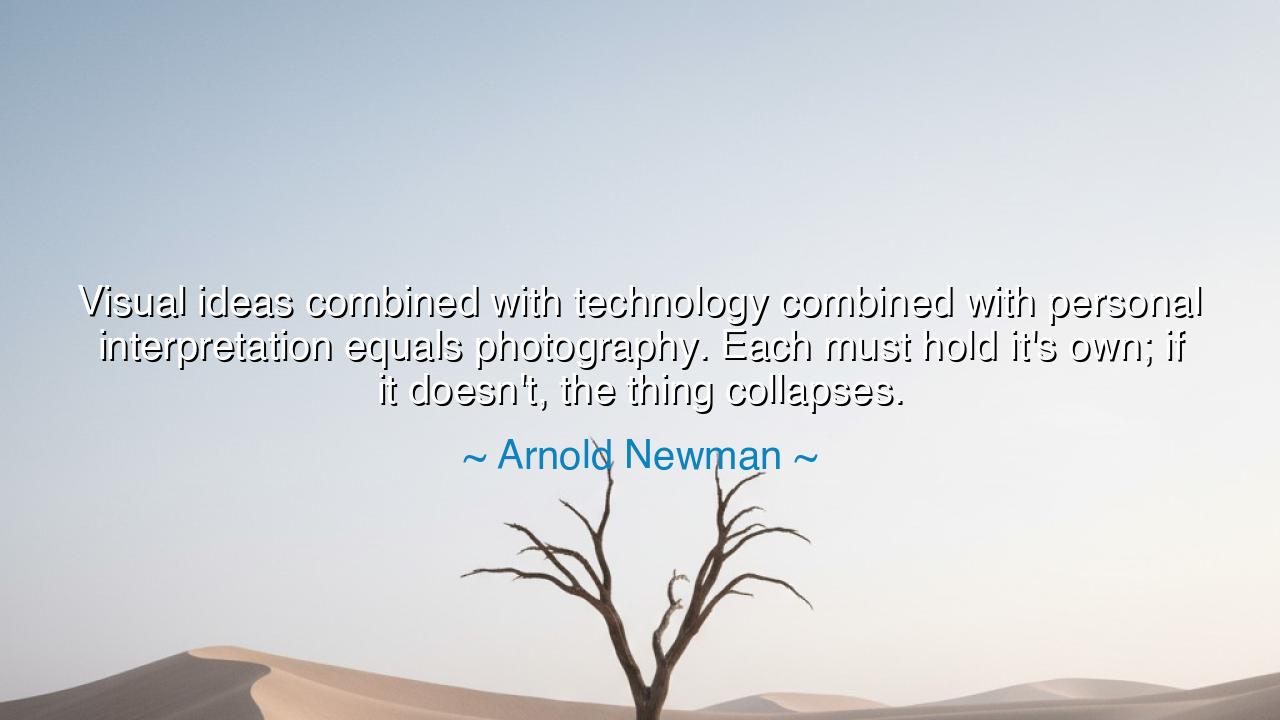
Visual ideas combined with technology combined with personal
Visual ideas combined with technology combined with personal interpretation equals photography. Each must hold it's own; if it doesn't, the thing collapses.






Hear, O seekers of vision, the words of Arnold Newman, master of portraiture: “Visual ideas combined with technology combined with personal interpretation equals photography. Each must hold its own; if it doesn’t, the thing collapses.” These words are not a simple formula, but a law of balance, a reminder that true art is born not from one element alone, but from the harmony of many. Photography, like all creation, stands at the meeting place of mind, machine, and soul, and if one falters, the whole structure crumbles like a house built upon sand.
When Newman speaks of visual ideas, he calls us to the fountain of imagination. It is not the camera that sees, but the eye that dreams. Without vision, the machine is blind, and the photograph becomes a mere record, a lifeless copy of reality. But vision alone is not enough, for the idea must be clothed in form, captured in time, preserved in light. Thus comes the second element: technology. The lens, the shutter, the tools of the craft—these are the instruments that give body to imagination. Without them, vision fades into mist.
Yet there is a third element, more mysterious and sacred: personal interpretation. Two photographers may gaze upon the same subject, wield the same machine, yet capture utterly different truths. For it is the soul that interprets, the heart that chooses what to reveal and what to conceal, the spirit that breathes meaning into light and shadow. Without interpretation, the image may be sharp, but it lacks soul; it may be clear, but it does not speak.
Consider the story of the great war photographers of the twentieth century. Their technology was crude by modern standards, their tools often heavy and limited. Yet armed with visual ideas and personal interpretation, they produced images that stirred nations and changed the course of history. The haunting photo of a child fleeing napalm in Vietnam—burning flesh, anguished face—was not merely a record of war, but a vision interpreted by the photographer’s soul. It combined idea, machine, and spirit into one enduring truth, shaping how the world saw conflict. Had any element been absent, the image would not have moved the human heart.
So Newman’s words are not only about photography, but about all creation and labor. Any work of worth requires vision, skill, and soul. A builder without vision makes a hollow house. A thinker without tools cannot shape thought into action. A craftsman without heart produces things that do not live. Each part must be strong, each must uphold the other, or else the endeavor collapses.
The lesson is timeless: balance your life’s works with imagination, skill, and authenticity. Do not lean only upon machines, for they are empty without vision. Do not dream without discipline, for dreams without form vanish like smoke. And do not labor without soul, for skill without spirit builds only monuments of dust. True creation, whether in art, in craft, or in living itself, arises from the unity of these three.
Practically, this means cultivating all sides of your being. Sharpen your visual ideas by studying beauty and truth. Master the technology of your craft, whether camera, pen, or tool, so that your ideas may be embodied. And most of all, nurture your personal interpretation—your voice, your soul, the mark that only you can leave upon the world. Let these three stand together, and your work will endure.
Thus the words of Arnold Newman echo across the generations: art, like life, collapses when one leg of the tripod is broken. But when vision, machine, and soul stand firm together, the image becomes eternal, and the work becomes not only creation, but revelation. Let this wisdom guide all who seek to capture not just what is seen, but what is truly known.






AAdministratorAdministrator
Welcome, honored guests. Please leave a comment, we will respond soon